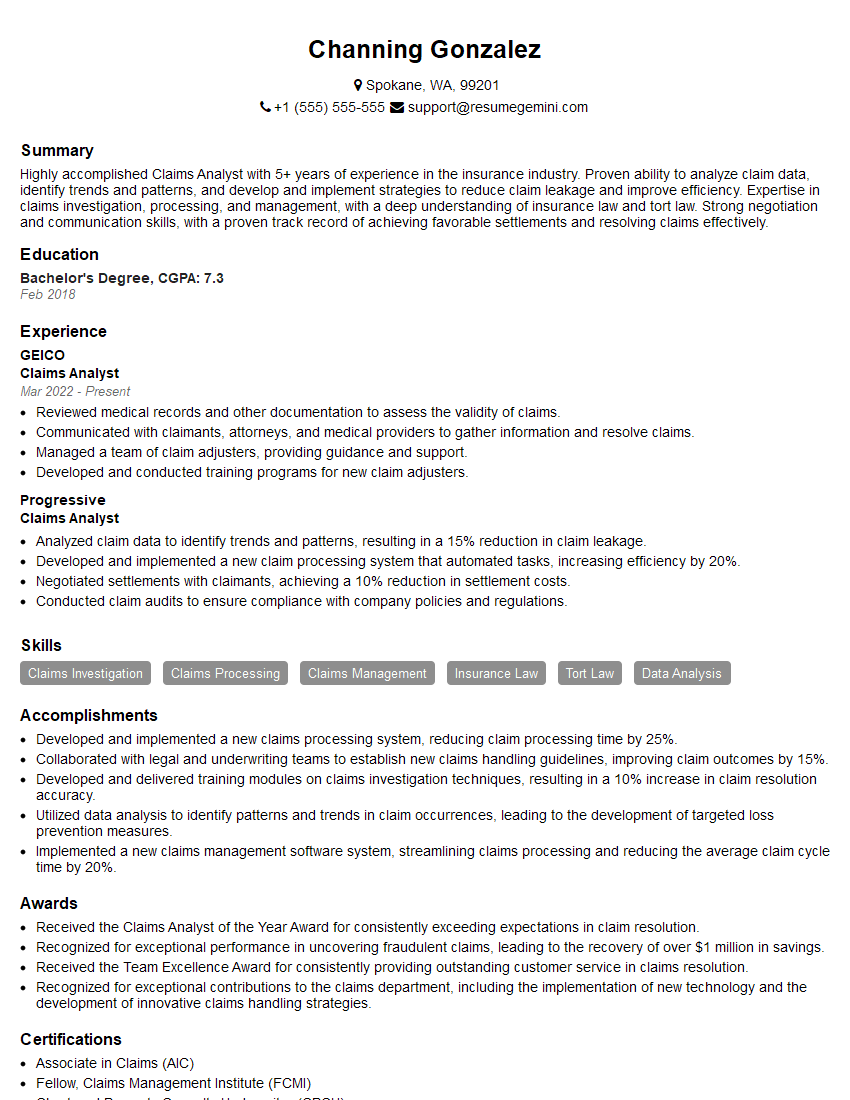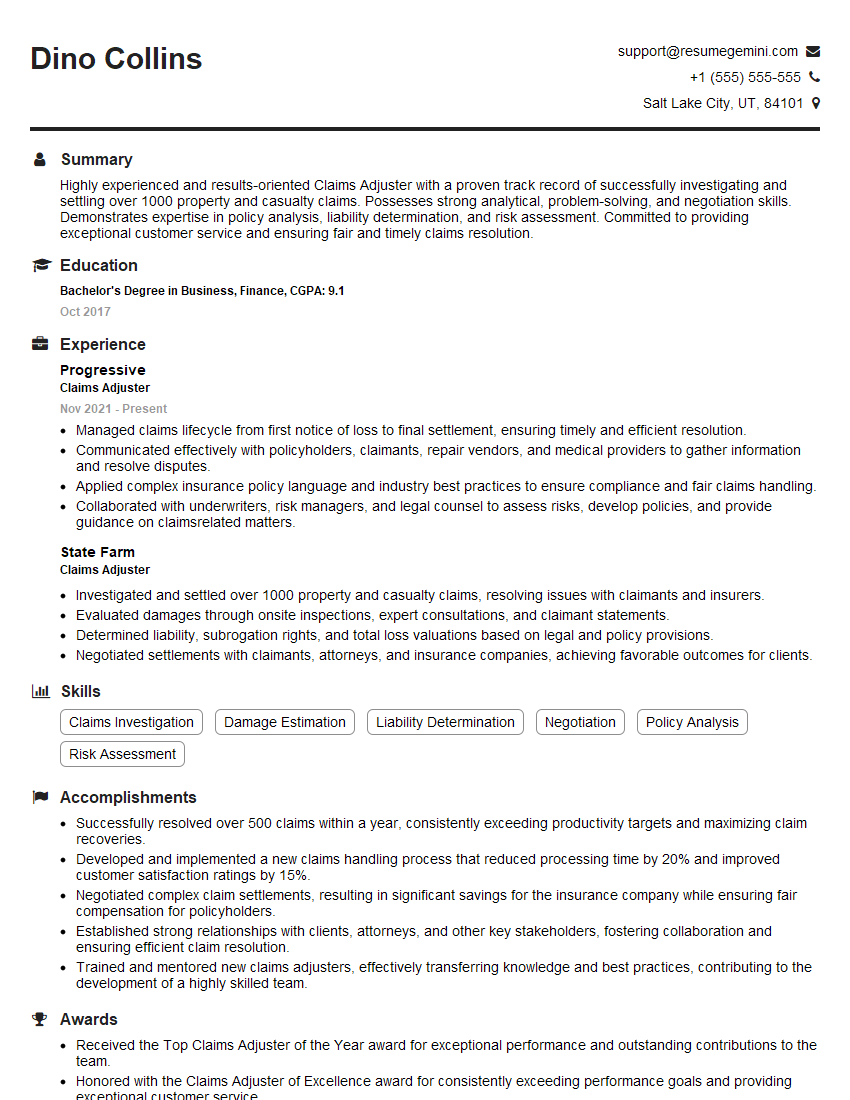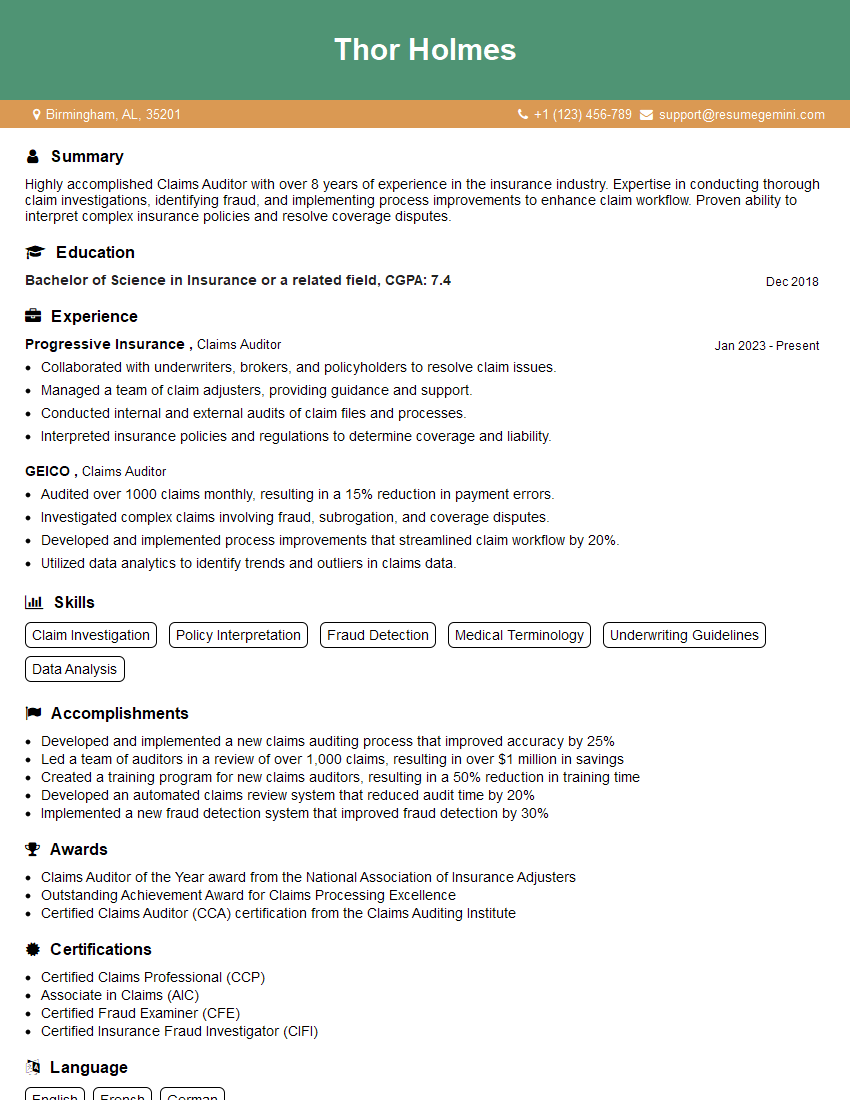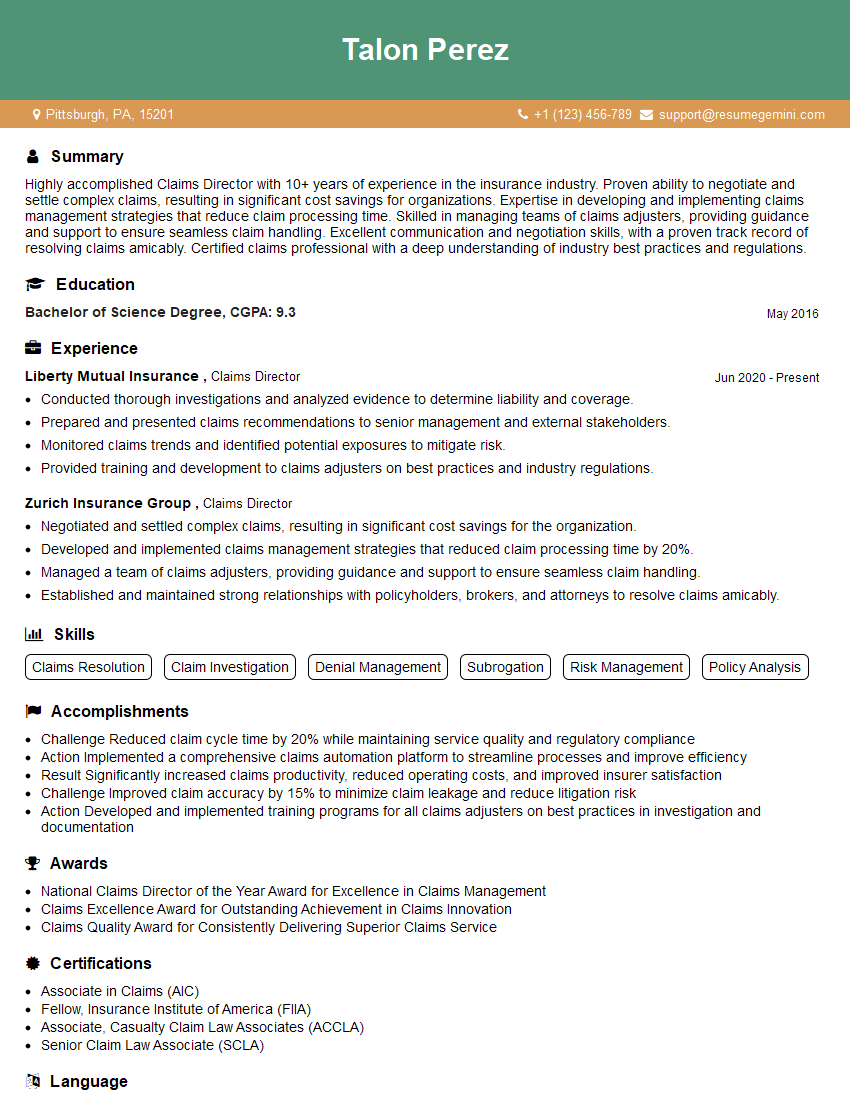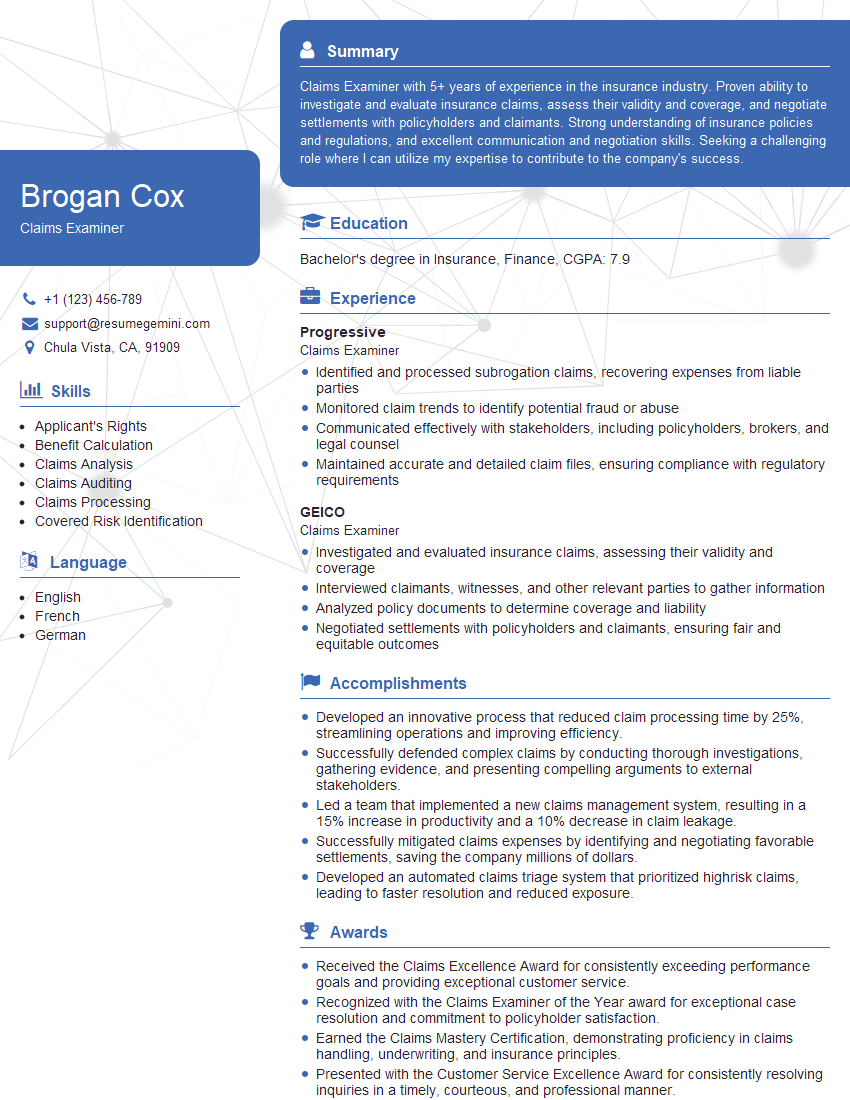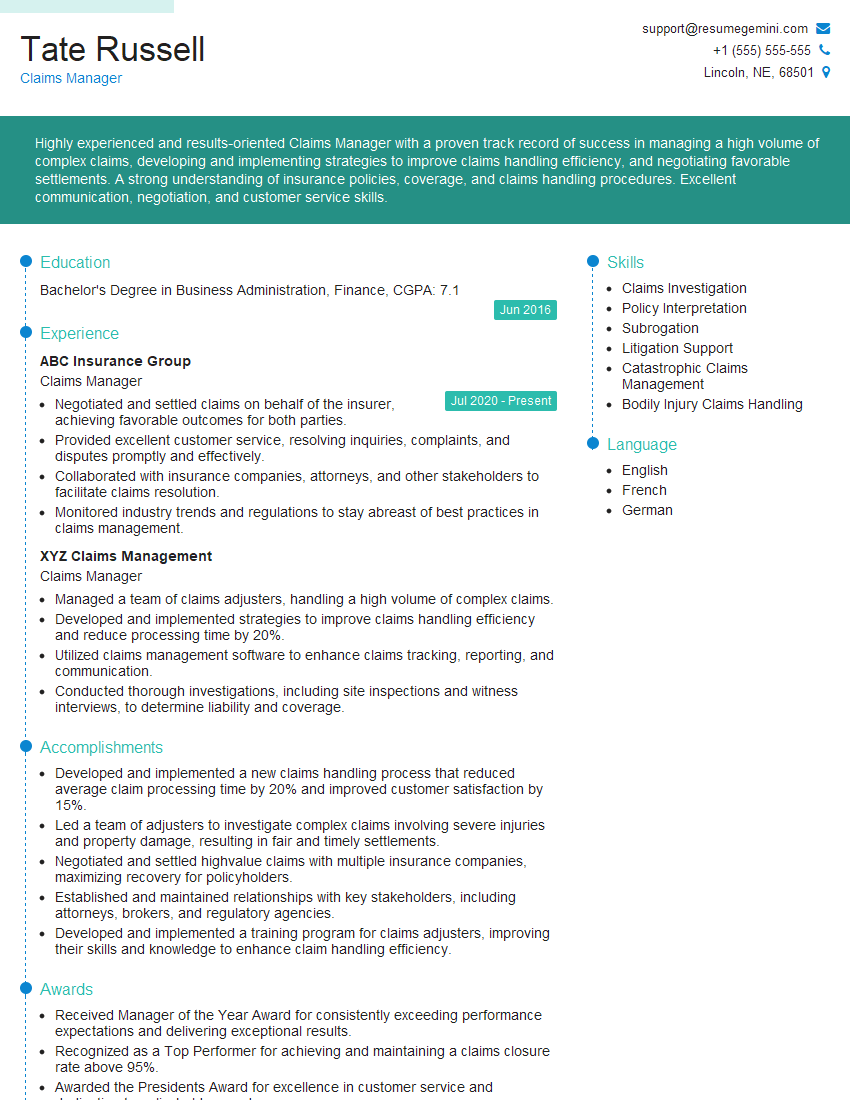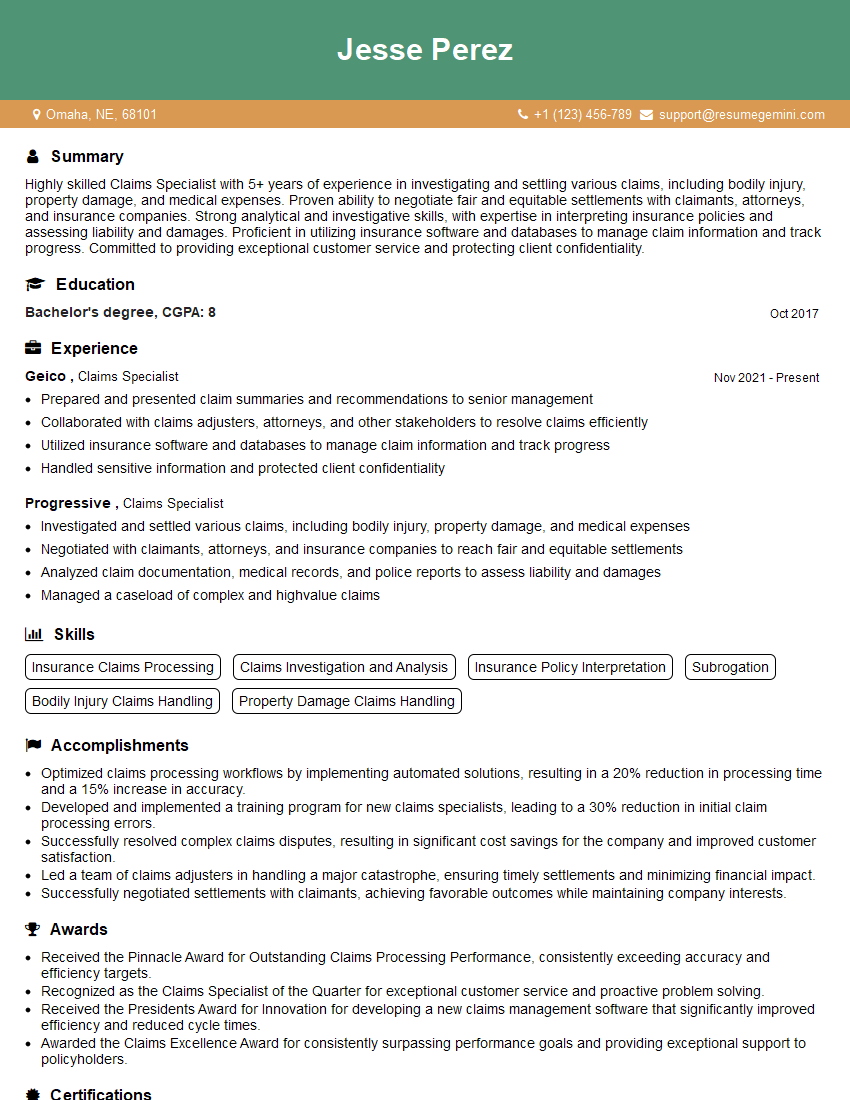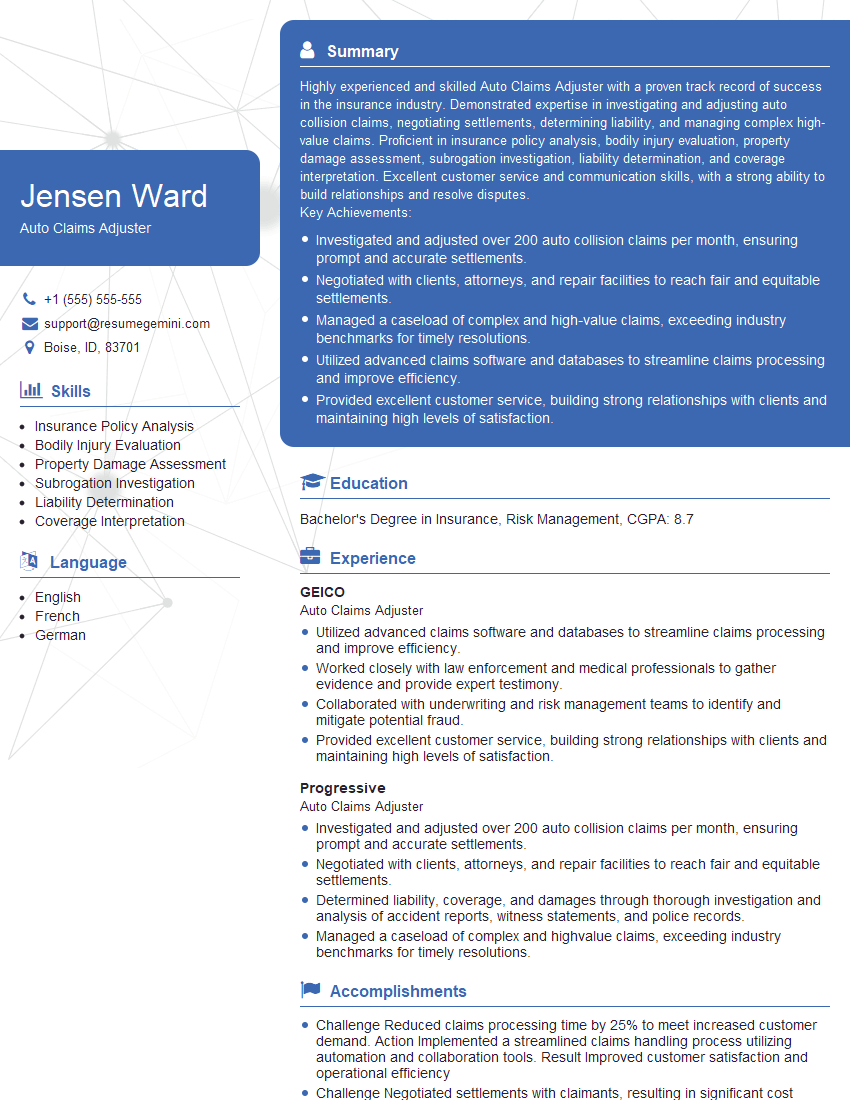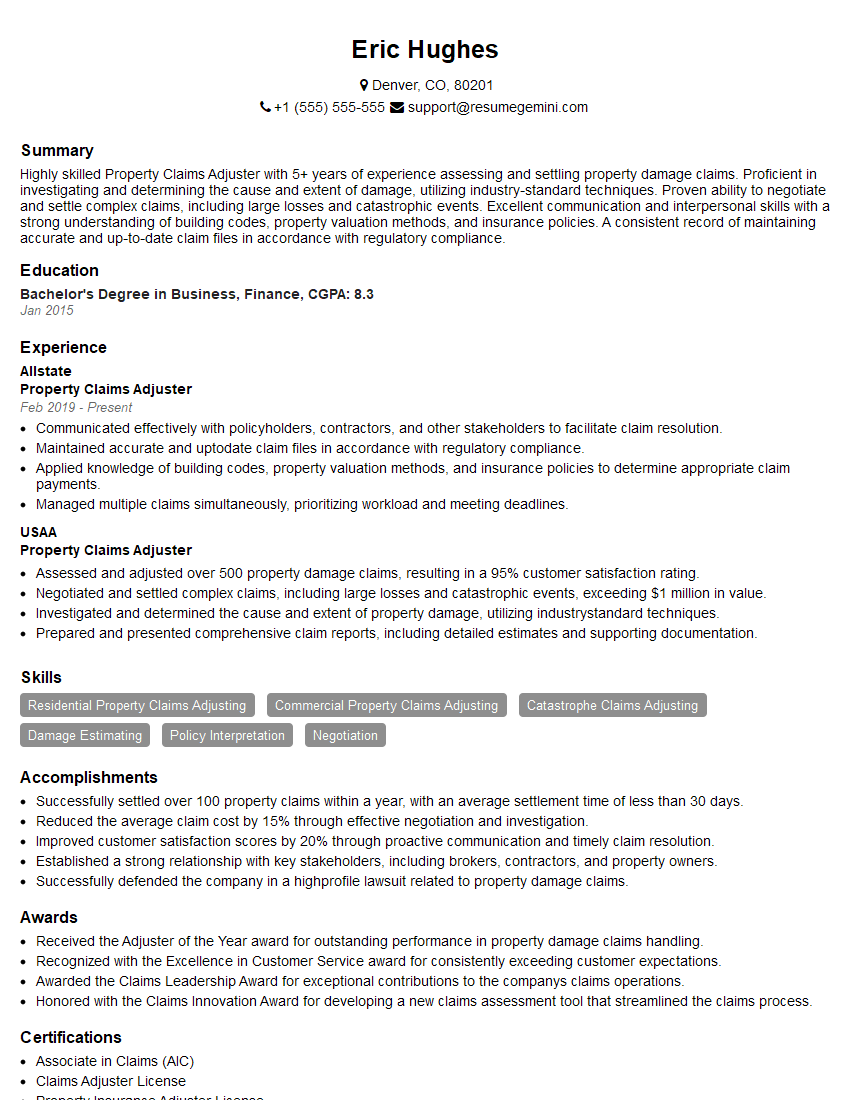Are you ready to stand out in your next interview? Understanding and preparing for Claim Drafting and Amendment interview questions is a game-changer. In this blog, we’ve compiled key questions and expert advice to help you showcase your skills with confidence and precision. Let’s get started on your journey to acing the interview.
Questions Asked in Claim Drafting and Amendment Interview
Q 1. Explain the process of drafting a comprehensive claim.
Drafting a comprehensive claim involves a meticulous process ensuring all relevant information is accurately and completely presented. It’s like building a strong case – every piece of evidence needs to be carefully placed to support the overall narrative.
- Gathering Information: This initial phase involves collecting all pertinent documents, witness statements, medical records (if applicable), photos, and any other supporting evidence. Think of it as assembling your puzzle pieces before you start to build the picture.
- Organizing the Information: Once gathered, the information needs to be organized chronologically or thematically, creating a clear and logical flow. This helps the reader understand the sequence of events and the supporting evidence.
- Writing the Claim Narrative: This is where you craft a clear, concise, and persuasive narrative that outlines the events leading to the claim, the losses incurred, and the basis for your request. This is the heart of your claim – the story that needs to resonate with the reviewer.
- Supporting Documentation: Each point made in the narrative must be supported by evidence. This means attaching all relevant documents, ensuring they are correctly referenced within the claim narrative. Missing supporting evidence is like a hole in your argument.
- Review and Editing: Before submission, the claim must be thoroughly reviewed and edited for clarity, accuracy, and completeness. A second pair of eyes is always helpful to catch errors and ensure consistent messaging.
For example, in a property damage claim, a comprehensive claim would include details of the incident, photos of the damage, repair estimates, and any relevant insurance policy documents.
Q 2. Describe your experience with amending claims.
My experience with amending claims spans over [Number] years, encompassing a wide range of scenarios. I’ve handled amendments ranging from minor corrections of typographical errors to significant revisions addressing new evidence or changes in circumstances. I approach each amendment with the same rigorous attention to detail as the initial claim draft.
For instance, I once worked on a liability claim where, initially, only one witness statement was available. Later, a second witness came forward, providing corroborating evidence. I amended the claim to include this crucial new information, significantly strengthening the client’s case. The amendment clearly detailed the new evidence and its relevance to the claim, ensuring a seamless integration with the existing documentation.
Another example involved an error in calculating lost wages in a worker’s compensation claim. I quickly identified the error, prepared an amendment correcting the figure, and submitted it with a clear explanation of the correction to avoid any delay or complications.
Q 3. What are the common reasons for amending a claim?
Claims are amended for various reasons, often due to unforeseen circumstances or newly discovered information. Common reasons include:
- New Evidence: Discovery of additional evidence, such as witness statements, medical records, or expert opinions, which strengthens or changes the initial claim.
- Corrections: Identifying and rectifying errors or omissions in the original claim, such as incorrect dates, amounts, or names. This shows attention to detail and enhances credibility.
- Changes in Circumstances: Amendments may be needed to reflect changes in circumstances, such as a change in the claimant’s medical condition or the settlement of related claims.
- Clarification: Adding detail or explanation to address ambiguities or questions raised by the insurer.
- Expanding the Claim: In some cases, the initial claim might be expanded to include additional losses or damages that were not initially apparent.
Q 4. How do you ensure accuracy and completeness in claim documentation?
Accuracy and completeness are paramount in claim documentation. I employ a multi-step process to ensure both:
- Detailed Checklists: I use detailed checklists tailored to the specific claim type to ensure all necessary information and documents are included.
- Cross-referencing: I meticulously cross-reference all information and ensure consistency throughout the claim documentation.
- Independent Verification: Whenever possible, I verify information from multiple sources to ensure accuracy. This helps mitigate the risk of errors or discrepancies.
- Peer Review: A second review by a colleague helps identify potential errors or omissions I might have missed.
- Technology: I leverage technology, such as claim management software, to help automate data entry and reduce the risk of manual errors.
Think of it like a surgeon performing an operation – precision and accuracy are non-negotiable. Any mistake could have serious consequences.
Q 5. How do you handle conflicting information within a claim?
Handling conflicting information requires careful analysis and documentation. My approach involves:
- Identifying and Documenting Conflicts: I meticulously document all conflicting information, clearly outlining the discrepancies.
- Investigating the Source of Conflicts: I investigate the source of the conflicting information, determining its reliability and potential biases.
- Reconciling Conflicts (if possible): I attempt to reconcile conflicts by gathering additional evidence or clarifying the information with involved parties.
- Transparent Presentation: If conflicts cannot be reconciled, I transparently present all conflicting information to the claim reviewer, providing context and analysis of each piece of information.
For example, if a witness statement contradicts a police report, I would present both, highlighting the discrepancies and offering my analysis of their credibility based on the evidence available.
Q 6. What are the legal implications of inaccurate claim drafting?
Inaccurate claim drafting carries significant legal implications. It can lead to:
- Claim Denial: Inaccurate or incomplete claims are frequently denied, leaving the claimant without compensation.
- Legal Challenges: Inaccurate information can be used against the claimant in legal proceedings, weakening their position.
- Fraudulent Claims: Intentional misrepresentation of facts constitutes fraud, which can lead to severe penalties, including criminal charges.
- Reputational Damage: Submitting a flawed claim can damage the claimant’s reputation and future claims.
- Financial Penalties: In some jurisdictions, penalties may be imposed for submitting false or misleading information.
Therefore, accuracy and completeness are not simply best practices; they are crucial to a successful outcome. It’s like building a house on a solid foundation; any weakness will eventually cause the whole structure to collapse.
Q 7. Describe your experience with different types of claims (e.g., property, liability, workers’ compensation).
My experience encompasses a wide range of claim types, including property, liability, and workers’ compensation. Each type requires a distinct approach and understanding of relevant laws and regulations.
- Property Claims: I have extensive experience in handling property damage claims, including residential and commercial properties, focusing on assessing damage, obtaining repair estimates, and documenting losses.
- Liability Claims: My work with liability claims involves investigating incidents, gathering evidence from witnesses and other sources, determining liability, and calculating damages.
- Workers’ Compensation Claims: I’m well-versed in handling worker’s compensation claims, understanding the complexities of medical evaluations, lost wage calculations, and state-specific regulations.
While the specifics differ, the underlying principles of accuracy, completeness, and persuasive storytelling remain consistent across all claim types.
Q 8. How do you prioritize claims based on urgency and complexity?
Prioritizing claims involves a balanced approach considering both urgency and complexity. Think of it like triage in a hospital – life-threatening cases get immediate attention, while less critical ones are addressed in order of severity. For claims, urgency might be dictated by deadlines (e.g., statute of limitations), potential financial exposure, or client pressure. Complexity, on the other hand, depends on the volume of documentation, number of involved parties, the ambiguity of the facts, and the legal precedents involved.
I use a matrix system to prioritize. I plot each claim on a chart with ‘Urgency’ on one axis and ‘Complexity’ on the other. High-urgency, high-complexity claims are tackled first. Then, I address high-urgency, low-complexity claims, followed by low-urgency, high-complexity cases, and finally low-urgency, low-complexity claims. This ensures that time-sensitive and legally challenging claims don’t get lost in the shuffle.
For example, a claim involving a serious accident with significant potential liability would be placed in the high-urgency, high-complexity quadrant, needing immediate attention. Conversely, a simple claim with complete documentation and a clear liability might fall into the low-urgency, low-complexity quadrant.
Q 9. What software or systems are you familiar with for managing claims?
I’m proficient in several claim management software and systems. My experience includes using both large-scale enterprise solutions like ClaimsPro and Guidewire, which offer robust features for tracking, analyzing, and reporting on claims data. These systems help manage large volumes of information, automate tasks, and ensure compliance.
I’m also familiar with smaller, more specialized software designed for specific industry needs, such as those used in medical malpractice or workers’ compensation. Moreover, I’m comfortable using project management tools like Asana or Trello to organize claims and collaborate with team members. The specific tool I use depends heavily on the organization’s needs and the nature of the claims being managed. Adaptability to different systems is crucial in this field.
Q 10. How do you handle claims with missing information?
Claims with missing information are a common challenge. My approach involves a systematic investigation to gather the necessary details. First, I clearly identify the missing information and its importance to the claim’s assessment. Then, I utilize a multi-pronged strategy:
- Internal Review: I thoroughly review existing documentation to see if the missing data might be embedded somewhere else.
- Client Contact: I directly contact the claimant or relevant parties to politely request the missing information, explaining its necessity and the potential impact on processing the claim.
- Third-Party Requests: If applicable, I contact third-party sources like hospitals, police departments, or insurance companies to obtain the necessary data, always ensuring I’m complying with relevant privacy regulations.
- Documentation Review: I review the initial claim documentation to understand why the information might be missing and if there’s a procedural explanation.
If after reasonable efforts, the crucial information remains unavailable, I’ll document this comprehensively, explaining my attempts to retrieve the data and outlining the potential impact of the missing pieces on the claim’s outcome.
Q 11. Explain your approach to investigating and verifying claim details.
Investigating and verifying claim details is a meticulous process requiring attention to detail and a critical eye. My approach is guided by several key principles:
- Gathering Evidence: I systematically gather all relevant documents, statements, medical records, photographs, police reports, and any other evidence supporting the claim. This forms the foundation for my investigation.
- Fact-Finding: I conduct interviews with claimants, witnesses, and other relevant parties to obtain firsthand accounts of the events. I document these interviews carefully, noting key details and potential inconsistencies.
- Verification: I meticulously verify the information obtained through cross-referencing different sources, comparing statements with supporting evidence, and analyzing the consistency and credibility of the information provided.
- Legal Research: I conduct thorough legal research to understand relevant laws, regulations, and precedents that may impact the claim’s outcome. This ensures that my investigation is legally sound.
For example, in a car accident claim, I’d verify the claimant’s injuries through medical records, police reports, and witness statements. I would also analyze the accident reconstruction report to determine fault.
Q 12. How do you communicate claim updates to stakeholders?
Keeping stakeholders informed about claim updates is paramount. My communication strategy emphasizes clarity, timeliness, and transparency. I use a variety of methods tailored to the audience and the context:
- Regular Updates: I provide regular updates to claimants, insurers, and internal teams through email, phone calls, or formal letters, depending on the preference and the importance of the update.
- Formal Reports: For significant developments or milestones, I prepare comprehensive written reports summarizing the claim status, key findings, and next steps.
- Client Portals: If the organization uses client portals, I leverage them to share updates and documentation electronically, ensuring easy access for stakeholders.
- Meetings: For complex claims or situations needing more in-depth explanations, I schedule meetings to discuss progress and address concerns.
I always maintain a detailed record of all communications, ensuring a clear audit trail. My goal is to keep everyone informed and involved, managing expectations and building trust.
Q 13. Describe a situation where you had to amend a claim due to new information.
In one case, we initially filed a claim for a slip-and-fall accident based on the claimant’s initial statement and a witness account. The claim detailed injuries including a broken leg. However, during the subsequent medical examination, it was discovered that the claimant had a pre-existing condition in that leg, which had been aggravated by the fall, not solely caused by it. This new information substantially altered the claim’s valuation.
We amended the claim to reflect this new medical evidence. The amendment included detailed documentation from the physician detailing the pre-existing condition and its impact on the injuries. This careful amendment ensured the claim accurately reflected the situation and prevented potential disputes or delays in processing. It was critical to demonstrate transparency and accuracy throughout the entire process.
Q 14. What strategies do you use to identify and mitigate potential claim issues?
Proactive identification and mitigation of potential claim issues are crucial. My strategies include:
- Early Case Assessment: Thoroughly reviewing each claim early on to identify potential problems like missing information, inconsistent statements, or lack of evidence. Addressing these early minimizes later complications.
- Risk Assessment: Evaluating the inherent risks associated with each claim, considering factors like liability, potential damages, and legal precedents. This allows for a proactive approach to managing risk.
- Regular Monitoring: Regularly monitoring the progress of each claim to ensure deadlines are met, procedures are followed, and evidence is gathered efficiently.
- Documentation Management: Maintaining meticulous records of all communications, investigations, and decisions to minimize the risk of errors and omissions.
- Compliance Review: Regularly reviewing the claim process to ensure compliance with all relevant regulations and procedures.
By proactively addressing potential issues, I aim to streamline the claim process, ensure fairness, and avoid costly delays or disputes.
Q 15. How do you ensure compliance with regulatory requirements when drafting and amending claims?
Ensuring regulatory compliance in claim drafting and amendment is paramount. It involves a multi-faceted approach, starting with a thorough understanding of all applicable laws and regulations – this includes state and federal statutes, as well as industry-specific rules and guidelines. For example, in the US, we must adhere to regulations under the Fair Credit Reporting Act (FCRA) if the claim involves credit information or the Gramm-Leach-Bliley Act (GLBA) if the claim involves customer financial information.
My process begins with a detailed review of the policy wording, the claim documentation, and the relevant regulations. I then meticulously craft the claim documentation to ensure all information is accurate, complete, and presented in a manner consistent with the regulatory framework. This involves careful attention to detail, using precise language that avoids ambiguity and potential misinterpretations. For instance, if a claim involves a specific medical diagnosis, I would cross-reference the diagnostic codes with standard classification systems (like ICD-10) to confirm accuracy and avoid any potential discrepancies that could lead to non-compliance.
Regular training and updates on evolving regulations are essential. I actively participate in professional development programs and maintain a library of relevant legal resources to ensure my knowledge remains current. Furthermore, I work closely with the legal department to address any complex or ambiguous situations to ensure full compliance before submitting or amending any claim.
Career Expert Tips:
- Ace those interviews! Prepare effectively by reviewing the Top 50 Most Common Interview Questions on ResumeGemini.
- Navigate your job search with confidence! Explore a wide range of Career Tips on ResumeGemini. Learn about common challenges and recommendations to overcome them.
- Craft the perfect resume! Master the Art of Resume Writing with ResumeGemini’s guide. Showcase your unique qualifications and achievements effectively.
- Don’t miss out on holiday savings! Build your dream resume with ResumeGemini’s ATS optimized templates.
Q 16. How do you handle objections or disputes related to claims?
Handling objections or disputes requires a structured and professional approach. My first step is to thoroughly review the objection, identifying the specific points of contention. I then gather all relevant documentation to support our position, including policy language, witness statements, medical records, and any other pertinent evidence.
Communication is key. I engage in open dialogue with the claimant and their representatives, explaining our position clearly and concisely. This might involve clarifying specific points of the claim, providing additional information, or negotiating a mutually acceptable resolution.
In some cases, mediation or arbitration may be necessary. I have extensive experience working with mediators and arbitrators to facilitate a fair and efficient resolution. If a settlement cannot be reached, we may have to proceed with litigation, where I would collaborate with our legal team to prepare and present a strong defense. Throughout this process, meticulous documentation of all communication and actions is maintained.
For example, I once handled a claim where the claimant disputed the value of damages. By carefully reviewing the appraisal report, comparing it to similar cases, and engaging in open dialogue, we were able to reach a mutually acceptable settlement that avoided lengthy litigation.
Q 17. Describe your experience with claim reserves and estimations.
Claim reserve estimations are critical for financial planning and accurate forecasting. My experience involves utilizing various methods, including statistical modeling, historical data analysis, and expert judgment.
Statistical modeling leverages historical claim data to predict future outcomes based on various factors such as claim type, severity, and location. Historical data analysis helps in identifying trends and patterns that can inform reserve estimations. Expert judgment comes into play, especially in cases with unique circumstances or limited historical data. I rely on my extensive experience and industry knowledge to adjust the model’s projections to account for factors that may not be fully captured in the data.
For instance, I may use a combination of a statistical model predicting average claim costs and expert judgment to account for potential inflation or specific medical complications in a high-value liability claim. Regular reviews and adjustments of these reserves are made based on claim development and emerging information to ensure accuracy and financial stability.
Q 18. How do you collaborate with other departments (e.g., legal, underwriting) on claim resolution?
Collaboration is crucial for effective claim resolution. I regularly interact with the underwriting, legal, and investigative departments. With underwriting, I work closely to ensure claims are processed according to the policy terms and conditions. We often discuss policy interpretations and coverage issues to avoid discrepancies and delays. With the legal department, I collaborate on complex claims that require legal expertise, potentially involving litigation or regulatory compliance.
With investigative departments, I coordinate to gather evidence, verify information, and identify potential fraud. For instance, in a case involving a suspected fraudulent claim, I work closely with investigators to gather evidence, conduct interviews, and ensure appropriate documentation is available to support the claim’s determination. Clear and frequent communication channels are maintained through regular meetings, email updates, and shared databases to streamline workflow and ensure transparency.
Q 19. What is your understanding of subrogation and its role in claim handling?
Subrogation is the process of recovering losses from a third party responsible for causing the damage. It’s a vital component of claim handling as it allows the insurer to recover funds paid out on a claim.
For instance, if our insured’s vehicle is damaged in an accident due to another driver’s negligence, we may pursue subrogation against that driver’s insurer to recover the costs of repairs. Identifying potential subrogation opportunities requires a thorough investigation of the circumstances surrounding the loss, collecting evidence to establish liability, and pursuing legal action if necessary.
My role in subrogation involves coordinating with legal counsel, investigating the accident circumstances, and assembling the necessary documentation to support a subrogation claim. This includes police reports, witness statements, medical records (if applicable), and repair estimates. Successful subrogation not only recoups losses for the insurer but also helps keep premiums lower for all policyholders.
Q 20. How do you handle claims involving fraud or suspected fraud?
Handling claims involving suspected fraud requires a cautious and systematic approach. The first step involves identifying red flags, such as inconsistent statements, conflicting evidence, or unusual claim patterns. I then immediately initiate a thorough investigation, working closely with our internal fraud investigation unit and potentially external investigators. This might involve reviewing documentation, conducting interviews, and using specialized software to identify patterns of fraudulent behavior.
If fraud is suspected, I document all findings meticulously and report them to the appropriate authorities, potentially including law enforcement agencies. In handling these sensitive cases, adherence to all relevant legal and regulatory requirements is paramount. This includes adhering to privacy laws, providing appropriate notification to the claimant, and maintaining thorough documentation of every step of the investigation.
For example, I once handled a claim that showed inconsistencies in the claimant’s statements and supporting documentation. This led to a comprehensive investigation that ultimately confirmed the fraudulent nature of the claim, preventing significant financial losses to the company.
Q 21. Explain your experience with different claim settlement methods (e.g., negotiation, mediation, litigation).
I have experience with various claim settlement methods. Negotiation involves direct communication with the claimant to reach a mutually agreeable settlement. This often requires careful evaluation of the claimant’s position, assessing the strength of our case, and crafting a settlement offer that balances cost and risk.
Mediation utilizes a neutral third party to facilitate communication and assist in reaching a settlement. Mediation can be particularly effective in complex or emotionally charged cases, providing a structured forum for productive discussion. Litigation, as a last resort, involves pursuing the claim through the courts. This requires preparing comprehensive documentation, working closely with legal counsel, and presenting evidence before a judge or jury.
The choice of settlement method depends on various factors, including the complexity of the claim, the amount of damages involved, and the claimant’s willingness to negotiate. My goal is always to achieve a fair and efficient resolution, whether through negotiation, mediation, or litigation. I strive to minimize legal costs and expedite the process for both the claimant and the company.
Q 22. How do you manage your workload and prioritize tasks effectively in a high-volume claims environment?
In a high-volume claims environment, effective workload management is crucial. I employ a multi-pronged approach. First, I utilize a prioritized task list, categorizing claims by urgency and complexity (e.g., immediate medical needs, routine claims, complex litigations). This allows me to focus on time-sensitive matters first. Second, I leverage technology; claim management systems with automated workflows significantly streamline processes. Third, I break down large tasks into smaller, manageable steps, preventing overwhelm. Fourth, I regularly review my workload and adjust priorities as needed, proactively identifying potential bottlenecks. Finally, I communicate openly with my team and supervisors, seeking assistance when facing capacity constraints. For instance, if I see a surge in specific claim types, I might suggest team training or process improvements to distribute the workload more evenly. Imagine it like a conductor of an orchestra: each musician (claim) needs attention, but the conductor (me) ensures the symphony (workflow) plays smoothly.
Q 23. How do you stay updated on changes in claim handling procedures and regulations?
Staying updated is paramount. I subscribe to industry publications and newsletters focusing on claims handling and relevant legislation. I actively participate in professional development activities, attending webinars and conferences to learn about the latest best practices and regulatory changes. I also maintain a network of colleagues in the field, exchanging information and insights. My company also provides regular training sessions and updates on internal procedures and policy changes. This multi-faceted approach ensures I remain knowledgeable about both the evolving legal landscape and our internal protocols. Think of it as constantly calibrating your navigation system; without regular updates, you risk getting lost.
Q 24. Describe your experience with claim audits and quality control measures.
I have extensive experience with claim audits and quality control. I’ve been involved in both internal audits, reviewing claim files for compliance with company policies and regulatory requirements, and external audits, responding to requests from regulatory bodies. My approach involves a systematic review, checking for accuracy in data entry, proper documentation of all communications and decisions, and adherence to established timelines. For instance, a common issue I look for is ensuring that all necessary medical documentation has been received and reviewed before a claim is finalized. Discrepancies are documented and corrective actions are implemented, leading to continuous improvement in our claim handling procedures. Quality control isn’t just about finding errors; it’s about proactively preventing them.
Q 25. How do you maintain confidentiality and protect sensitive claim information?
Confidentiality is paramount. I strictly adhere to company policies and relevant data protection regulations (like HIPAA in the US). This involves securely storing and accessing claim information, using password-protected systems and adhering to strict access controls. I only share information on a need-to-know basis with authorized personnel and never discuss sensitive details in public spaces. Furthermore, I regularly update my knowledge of data security best practices, including recognizing and responding to potential threats. Protecting sensitive information is not just a policy; it’s a personal responsibility, and I take this seriously.
Q 26. What is your approach to documenting and tracking claim progress?
I utilize a combination of methods to track claim progress. Our company’s claim management system plays a central role; it provides a centralized repository for all claim-related documentation and allows for real-time tracking of each claim’s status. I also maintain detailed notes within the system, documenting all communication with claimants, medical providers, and other stakeholders. This detailed record-keeping allows me to quickly access the history of a claim at any stage, aiding in efficient handling and facilitating accurate reporting. Think of it like a meticulously maintained logbook for a ship; it shows the course of the journey and allows for adjustments as needed.
Q 27. Describe your experience with claims involving complex medical terminology or procedures.
I’ve handled numerous claims involving complex medical terminology and procedures. In such cases, I rely on my knowledge of medical terminology and my ability to research complex medical information. I often consult with medical professionals or utilize reputable medical resources to gain a clearer understanding of the medical aspects of a claim. I ensure clear and concise documentation within the claim file explaining any ambiguities or complexities, making the claim process transparent and understandable for all parties involved. For instance, when reviewing a claim involving a rare surgical procedure, I might consult a medical dictionary or journal to fully grasp the intricacies of the treatment before making a decision about the claim. The goal is to always be well-informed, providing accuracy and fairness.
Q 28. How do you adapt your approach to claim handling based on different types of claimants?
My approach adapts based on the claimant’s needs and circumstances. For instance, I tailor my communication style based on their understanding of the process. Claimants who may be unfamiliar with insurance procedures require a more patient and detailed explanation. While, for those familiar with the process, a more concise communication will suffice. I also take into account factors like age, language, and any disability when interacting with claimants. Empathy and sensitivity are vital aspects of my approach, ensuring claimants feel heard and understood throughout the process. I treat every claim, and every claimant, as unique and adjust my communication strategy accordingly. The ultimate goal is to ensure a fair and efficient process for all.
Key Topics to Learn for Claim Drafting and Amendment Interview
- Understanding Claim Construction: Grasping the nuances of interpreting claim language and its impact on patent validity and infringement analysis. This includes exploring various claim limitations and their legal interpretations.
- Practical Application: Analyzing claim language in real-world patent documents, identifying ambiguities, and proposing clear and concise amendments to strengthen claims or address objections during prosecution.
- Amendment Strategies: Developing effective strategies for amending claims to overcome rejections from patent offices, focusing on maintaining claim scope while addressing examiner concerns. This includes understanding the implications of claim amendments on the overall patent.
- Doctrine of Equivalents: Understanding this legal doctrine and its role in determining infringement even when literal claim language isn’t met. Knowing how to draft claims to minimize vulnerability to this doctrine.
- Claim Drafting Best Practices: Learning how to craft clear, concise, and unambiguous claim language that effectively protects the invention while minimizing the risk of invalidity challenges. This includes understanding different claim types (e.g., independent, dependent).
- Prosecution History Estoppel: Understanding how amendments made during patent prosecution can limit the scope of the claims in subsequent litigation. Knowing how to navigate this legal principle during drafting and amendment processes.
- Patent Litigation Context: Applying your understanding of claim drafting and amendment to the context of patent litigation, considering how claim interpretation impacts infringement and validity arguments.
Next Steps
Mastering Claim Drafting and Amendment is crucial for career advancement in intellectual property law, opening doors to specialized roles and increased earning potential. A strong understanding of these concepts demonstrates a high level of expertise and analytical skill highly valued by employers. To significantly boost your job prospects, crafting an ATS-friendly resume is paramount. ResumeGemini is a trusted resource for building professional resumes that effectively showcase your skills and experience. Use ResumeGemini to create a compelling narrative that highlights your capabilities. Examples of resumes tailored to Claim Drafting and Amendment are available to help guide you.
Explore more articles
Users Rating of Our Blogs
Share Your Experience
We value your feedback! Please rate our content and share your thoughts (optional).
What Readers Say About Our Blog
Hi, I represent an SEO company that specialises in getting you AI citations and higher rankings on Google. I’d like to offer you a 100% free SEO audit for your website. Would you be interested?
good
